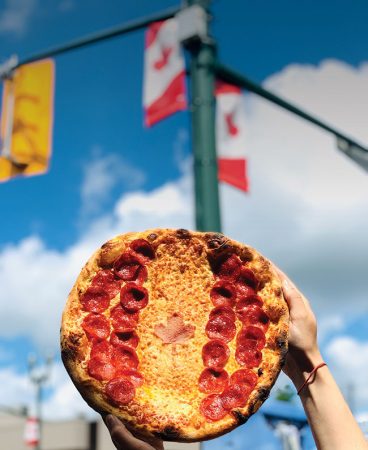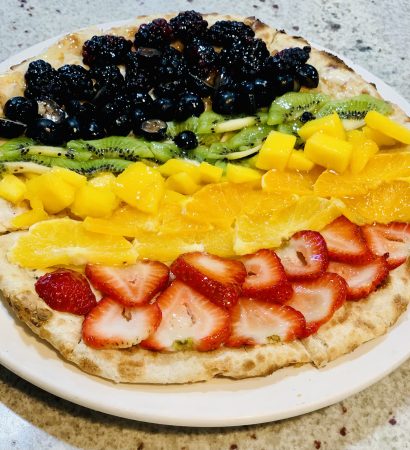
Be Insta-worthy!
By Andrew Hind
FeaturesTips for building your pizza brand on social media
 PHOTO COURTESY BLUEBIRD CAFÉ AND GRILL.
PHOTO COURTESY BLUEBIRD CAFÉ AND GRILL. Many pizzerias are run by small-business owners, people whose time is stretched thin by the myriad demands of operating a restaurant. Do they really need to add one more thing on their plates? If that one thing is establishing a robust and engaging social media presence, then the answer is yes.
“Social media is the way people connect and seek information today. As a marketing tool it is invaluable as it allows you to directly speak to your consumer in the fastest way possible,” explains Bruce Irving, founder of Smartpizzamarketing.com. “Social media is vital to success in today’s marketplace. 2020-21 proved it; even companies that were slow to use social media embraced it during the pandemic as a way of connecting with consumers and remaining front of mind during lockdowns.”

Rick and Michelle Arsenault of the Bluebird Café and Grill in Orangeville, Ont., are known for their creative social media posts.
Michelle and Rick Arsenault, owners of Bluebird Café and Grill in Orangeville, Ont., agree. Their business has grown immeasurably since they began creating fun videos for TikTok. “People are on their phones all day, for both entertainment and information, so when we decided we wanted to market ourselves in a new and exciting way while still being authentic to who we are, the videos seemed the perfect choice,” Michelle explains. “We’ve seen our business growing faster than ever since we began last year, despite the lockdowns.”
Not leveraging social media is a missed opportunity. The experts are clear on that. But how does one use these technologies – Facebook, Instagram, TikTok and others – to grow their business? We’ll try to answer that question in this article.
Getting started
“Mastering social media isn’t something that happens overnight. You weren’t born with the knowledge of how to ride a bike, you had to practice in order to improve. The same applies with social media,” Irving asserts.
The social media world is not monolithic. What works in one community may not work as effectively in another. Begin by spending a week looking at what platforms other restaurants in your community are on, how they are using social media, and what kinds of posts get the most engagement. Learn from others and use what you’ve learned to your advantage.
“It will take some time developing content and messaging skills,” Irving explains. “Start with one platform and practice making content on it. After three months, you’ll have a good base of data about what content people are interested in. Spend the next three months putting into practice what you’ve learned from studying the results of first three. After six months, you should be pretty competent and can start another platform.”
Be searchable
This begins with selecting an easily recognizable username and using relevant business keywords in your profile to help increase search results. Add unique branding and location-specific hashtags to your posts to help customers find you. A few strategically selected hashtags are all you really need: adding half a dozen or more is superfluous, detracts from your post, and suggests not knowing your target audience.
Leverage your employees
It’s possible – perhaps even probable – that some members of your restaurant team are more comfortable with social media and more skilled at its use than you are. Use this to your advantage.
“Social media ages up. It begins with younger people and then is embraced by more mature individuals and businesses,” Irving says. “Ask younger generation employees what platforms they use, and how. It will give you a foundation to work with.” And don’t be afraid to ask for help in crafting postings.
Interact with followers
The beauty of social media is it allows businesses to speak directly with consumers. But for any conversation to be rewarding, it must me a two-way street. It’s not enough to post photos. If someone comments on a post, be sure to take the time to respond. Even if someone is simply saying, “I love your pizza,” make the effort to thank them. Creating a true relationship generates loyalty.
Relationships, in turn, can grow into a community. Encourage this by involving your customers. Challenge them to share photos including your restaurant tag, and reward those who do in some meaningful way – the individual whose post garners the most likes can receive a gift card, for example. Creating a new dish? Ask your customers to name it. In both cases, people will feel compelled to continue following you to learn the end result of the contest.
“We try to be consistent with the timing of our posts,” Rick Arsenault explains. “Business-related posts are done in the morning, fun ones around 9 p.m. when people are winding down for the night and want a bit of entertainment.”
Make dishes Insta-worthy
In the social media era, it’s not enough for any restaurant to simply serve food that tastes good. It has to look good – no, it has to look great – as well. The reason is twofold. First, you’ll want to post enticing photos on your various social media feeds. Additionally, dishes that are a feast for the eyes will have patrons taking photos and sharing them on their own accounts, reaching far more potential customers than you ever could on your own. In the Instagram era, you may need to improve your décor too.
Get personal
Social media certainly can be leveraged to highlight specials of the day and showcase your menu. But if that’s all you’re doing, you’re missing out – and so too are your customers. Instead, use social media to introduce yourself to viewers.
“We started doing videos to showcase who we are,” Rick Arsenault says. “People already know what we do and what we offer. We found that customers wanted really wanted to get to know us and our staff – the people who took their orders, made their meals and delivered their food.” As part of that initiative, Bluebird Café posts Staff Star Saturdays, where they profile a new employee each weekend.
Irving recommends about 80 per cent of posts should be about what you do, and 20 per cent about you. “But this is just a loose rule,” he explains. “If you are charismatic and fun, maybe you focus a bit more on yourself. You’ll find the right balance for your own business based upon engagement feedback.”
Stay on brand
It’s important that posts stay on brand, both in terms of voice and appearance. Just as you want consistency of food and service, so too should you strive for consistency on social media. While you naturally want some variety on what you post, you can’t be haphazard and expect positive results.
Make sure you know what you want your focus to be – whimsical video stories, beautiful photos of dishes, behind-the-scenes tutorials – and gear your social media marketing efforts to that end. Clarity is vital. “If I were to go to your Instagram, I should easily see what it is you do: the type of food you serve, the atmosphere, the brand of your establishment,” says Irving. “It should be unmistakable.”
Have fun
Finally, have fun. Social media is an opportunity to express yourself, to engage with the public, to share some of the passion you find in being a restaurateur.
“We’re in the business of making people happy,” Michelle Arsenault explains. “People have commented that our videos brighten their day or make them laugh. That’s what hospitality is all about.” | CP
Print this page
